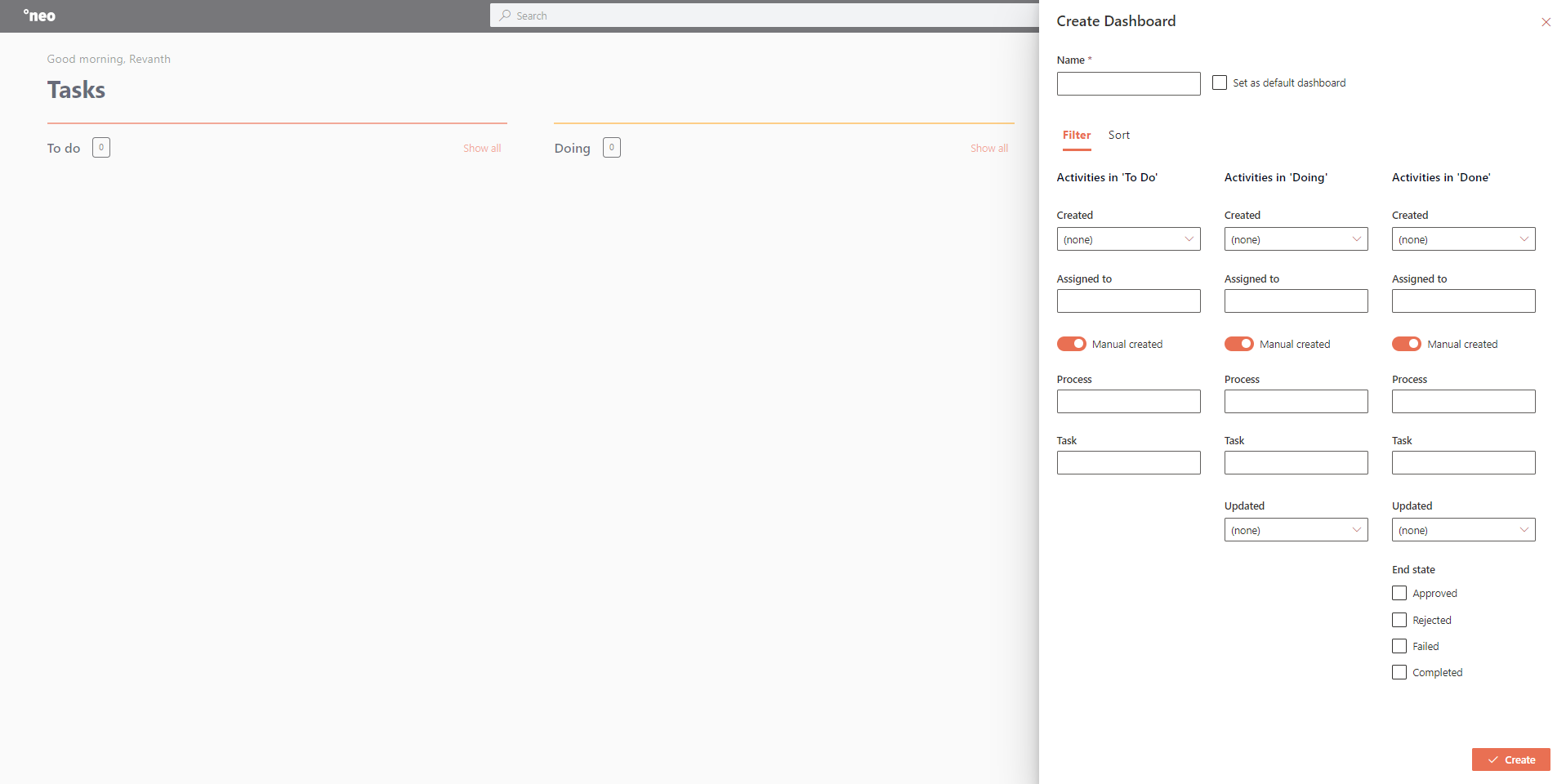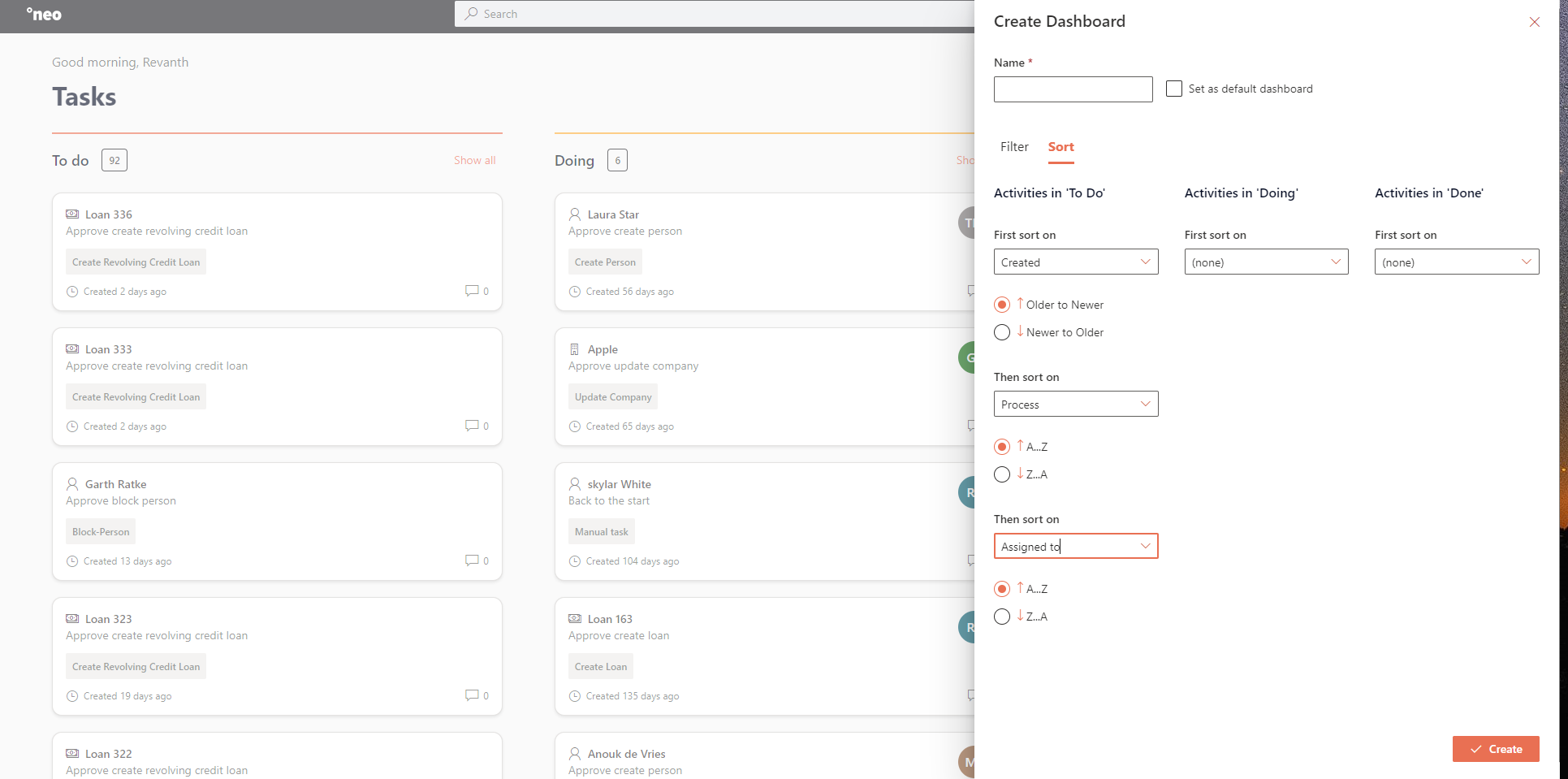Dashboard
Introduction
When you log in to the Client Service Portal or when you click on Akkuro in top left corner, you will be brought to the start page of the portal which displays the ‘Dashboard’. The Dashboard allows you to different tasks.
Kanban board
The KanBan board allows you to see all the relevant tasks that require further manual action. The KanBan board divides these tasks into three categories (aka ‘swimlanes’), under which the five tasks per swimlane are displayed.
Above the KanBan board on the right there is a dropdown menu with all available KanBan filters. When you log in for the first time there will be a default system filter applied called ‘My tasks’, showing only tasks that are assigned to you.
Next to the dropdown menu there are 3 icons:

By clicking the filter and gear, a side pane is opened where you can define a new KanBan board filter. In the name you can define the name of the filter, which will show up in the filter dropdown menu. You can also select to make the filter a default filter, so that it will be displayed when logging into the system.
Below the name there are 2 tabs: Filter and Sort. In the Filter tab you can define what task should be shown for each swim lane of the KanBan board. The input fields under ‘Filter’, are described in the table below:
| Field | Description |
|---|---|
| Choose types | Here you can select the task types you want to see. You can select Alert, Manual Task and Process Task. Process task are created as part of Process (e.g. 4-eyes Approval task). Manual task are created manually (for more details see link [MANUAL TASKS)]. Alerts are created when Long Running Operations are failing (for more details see…) |
| Process | When you have selected Process Task under Choose types this field is available. Here you can select the name process(es) you want to see the Process Tasks for. |
| Created | Here you can select ‘On’, ‘Before’, ‘From’ and ‘Last period’. When you select ‘From’ a second field is inserted where a user can optional define a before date. When you select ‘Last period’ a user can select from a dropdown from which last period task should be shown. |
| Assigned to | Here you can define one or more users or user groups to whom the tasks that you want to see are be assigned to. |
| Task | Here you can select the name(s) of tasks you want to see. |
| Updated | This filter is only available on the Doing and Done swim lane. Here you can define a date or period the same way as the Created field and this will show only tasks that comply to the selected date(s). |
| Choose end state | This filter is only available on the Done swimlane. Here you select the end states of the Tasks that should be shown on the Done swimlane. |

On the sort tab, you can select up to 3 sorting criteria per swimlane and indicate if the criterium should be sorted Ascending or Descending.

When you have defined both the Filter and Sorting tabs and have given the filter a unique name, you can click on the ‘Create’ button. Now the Dashboard filter is created and can be selected from the dropdown.
Next to the filter settings icon, the dashboard also has a pencil icon and trash can icon. When you click on the pencil icon you can update the selected KanBan board filter. When you click on the trash can icon it is possible to delete the filter.
From the KanBan board, when you click on ‘Show all’, a full list of tasks from the selected swimlane are displayed. From here you can select and open a task to further work on it. By clicking on a task, you are brought to the relevant entity (person, company or product) page and the task is opened in a sidebar. From here you can complete the necessary work and approvals required to close the task. For more information on tasks see Task Management.
The task cards themself also contains some relevant information, which is described below:

| Number | Description |
|---|---|
| 1 | Task title. |
| 2 | Process name. |
| 3 | Indication how long ago the Task was Created or Completed. |
| 4 | Number of comments on the Task. |
| 5 | Assigned user/user group avatar. A round avatar refers to a specific user and a square avatar refers to a usergroup (e.g., department). |
Updated 10 days ago